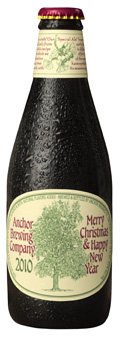
Time was when today, the Monday before Thanksgiving, was the traditional day on which Anchor’s Our Special Ale — a.k.a. their Christmas Ale — was released each year. Every year since 1975 the brewers at Anchor Brewery have brewed a distinctive and unique Christmas Ale, which is now available from early November to mid-January.

From Anchor’s website:
The Ale’s recipe is different every year—as is the tree on the label—but the intent with which we offer it remains the same: joy and celebration of the newness of life. Since ancient times, trees have symbolized the winter solstice when the earth, with its seasons, appears born anew.
Until recently, Anchor’s Christmas Ale was not released until the Monday before Thanksgiving each year. A few years ago they bowed to pressure from their distributors, who wanted to have it earlier to compete against all of the other holiday beers that are released much earlier. So while I can’t argue it’s a bad thing to have this wonderful beer both earlier and for a longer period of time each year, I do actually miss it coming later on a very specific date. There was something I really liked about having to wait for it — admittedly vague and unspecific, but the feeling was there all the same. And there was something I admired about their stubbornly refusing to release it until they were damn well ready. I think it added something intangible to the beer’s mystique, making it more special somehow.
I realize I sound like a sentimental fool, but beer (and many other things) used to be ruled by the seasons and their availability was something that created anticipation and deep satisfactions, too. To me fruit is a great example. Wait, hear me out. There was a time when you couldn’t get almost every fruit year round, but now thanks to agreements with growers in the Southern Hemisphere, we can get most of them all year long. But the very fact that they’re around all the time makes them less desirable. How much better did a strawberry taste when you couldn’t eat one all winter and they suddenly appeared each spring?
Of course, I don’t really think Anchor’s Christmas Ale will lose much — or any — of its specialness by being released a couple weeks sooner each year. I know I still wait eagerly to try the new one each year. But I really think there is something to building up demand and the perceived value that artificial scarcity brings. And there are beers that have suffered for going from a seasonal to a year-round beer. Mendocino’s Eye of the Hawk comes to mind. Back in the early 1980s they only brewed it three times a year (for the 4th of July, their annual anniversary and Oktoberfest). They released the strong ale in 22 oz. bottles in limited quantities and it sold out quickly like clockwork every time it was released. That went on for years until around 1999, when they made it available all the time and in unlimited quantities. Sales fell and although it sold steadily, we sold more in three bursts than when it was always there. Let’s also not forget that seasonals are now the number one craft category at mainstream outlets like grocery and liquor stores. It’s clear people like picking up something different. I don’t think we’ll see popular everyday beers going away, but it should be remembered that limited and seasonal releases can have their own cache and sell better in direct proportion to the difficulty in obtaining them.
Today I’m celebrating “Anchor Christmas Ale Day” and picking up some more today, I’ll drink some tonight, and also save some for my Thanksgiving Day meal on Thursday. This holiday will continue to be the Monday before Thanksgiving, to honor the idea that some things are worth waiting for.
But back to Anchor’s “Our Special Ale.”
Each year our Christmas Ale gets a unique label and a unique recipe for the Ale itself. Although our recipes must remain a secret, many enthusiasts save a few bottles from year to year—stored in a cool dark place—to taste later and compare with other vintages. Properly refrigerated, the beer remains intriguing and drinkable for years, with different nuances slowly emerging as the flavor mellows slightly.

This year’s label has one more unique feature that makes it different from the 35 that preceded it. Take a good look at the label, you probably won’t notice it. I didn’t. Every other label included the Latin name for the tree. But this year’s tree was the Ginkgo biloba tree and our intrepid TTB would not allow the words “Ginkgo biloba” to appear on the label for fear that someone might think the beer contained the drug Ginkgo biloba, despite the fact that for the last 35 years having the Latin name has never been a problem. You’d think there might have been some precedent set, but alas, no. I’m told Anchor considered appealing the decision and fighting it, but in the end decided it wasn’t worth the effort. But it certainly feels like a bureaucratic snafu that serves no legitimate purpose. Oh, well.
Over the years, there have been 36 different labels and each year Anchor prints a beautiful poster with all of the past labels plus the current years’ label.

Note: If this sounded familiar, I posted this same rant a couple of years ago, but decided it should be an annual thing.


